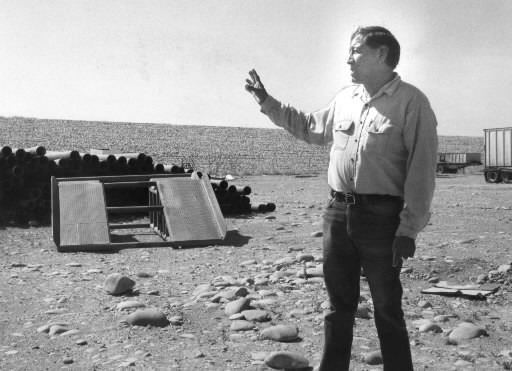6. A Lethal Legacy
Jan. 18, 2013
Chapter 1: The United States
Part 3: Uranium Mining on the Navajo Reservation
Part 3: Uranium Mining on the Navajo Reservation
The work carried out by Navajo men was not confined to the mines—they were also the main source of labor for the uranium refineries, where solvents were used to extract the ore. We were sitting in a diner in Shiprock, the former center of the "uranium rush," when a tanned Navajo man called out to us:
"You Japanese? Whaddya doing in a place like this?" When we replied that we were looking for people who had worked at the uranium refineries, he told us that we had come to the right place, and that he would gladly talk to us.
Russen Tohdacheeny, now an employee of the Indian Affairs Bureau, had started work at the Kerr-McGee uranium refinery in Shiprock in 1954, after three years in the navy. His first work at Kerr-McGee was adding sulfuric acid to the excavated rock to extract the uranium. Soon after he was moved to the last stage of the refining process, where his job was to pack the yellowcake into large drums, the doors and windows of the buildings were closed to prevent the humidity level from rising. "We had these small masks," Tohdacheeny continued, "but it was far too hot to wear them. We used to give the drums a whack so that the stuff settled: when we did that, clouds of it would rise up in the air--we were covered in yellow powder all day."
After work the men would go home without changing, and wear the same clothes the next day. The dust that gathered on the roof of the refinery alone was said to be worth $100,000. These were the abominable conditions under which Tohdacheeny and 120 fellow workers had to work. Tohdacheeny could not recall ever having a medical checkup.
He stayed at the refinery for four years before leaving to join the police force, where the pay was better. "But I've heard lately that some of my friends who stayed on have got lung cancer," he said with obvious concern.
At one time there were as many as twenty-five refineries in operation in the Midwest uranium mining belt, seven of those located in the Four Corners region. The four refineries of Shiprock, Monument Valley, Tuba City, and Mexican Hat were located on Navajo reservations. All the refineries began operations in the late fifties or early sixties, and all closed down in the seventies when the American uranium mining industry lost out to competition from Canada and Africa. They left behind a lethal legacy, however: piles of tailings loaded with radioactive byproducts of the refining process.
Only two pounds of uranium can be extracted from each ton of ore. The rest is waste. According to information supplied by the DOE, there are nine million tons of this waste in the reservation areas alone, and thirty million tons in all on abandoned refinery sites in the Midwest. The residents recently became aware of the danger of the dust from this conveniently forgotten waste blowing down onto the reservations and began to demand that steps be taken to prevent their villages from becoming covered in radioactive dust. In 1982 this resulted in attempts to clean up the environment. The DOE's strategy has been merely to cover the piles of rubble with earth to stop the dust flying around. Operations were completed at Shiprock in 1987 and the cleanup at the other three reservations was to be finished by 1991.
We found the site of the former Shiprock refinery covered in rocks. Although the site was only three hundred yards from the center of town, waste material was buried under these rocks. Until 1987, the exposed dust from the abandoned tailings was frequently blown through the city, which has a population of thirty-five thousand.
"It's just a damn crime, that's all there is to it," were Tohdacheeny's parting words.








